How to Manage Out of Stock Products to Preserve Your SEO
Note: This strategy is not exclusive to e-commerce websites; the issue just happens to be more common on e-commerce sites as products often become discontinued or go out of stock. If you have any pages with products or services on your website that could be discontinued or may become temporarily unavailable, this article will be beneficial to you.
If you manage an e-commerce website, then it is very likely that at some point, you are going to have a product that is temporarily sold out or discontinued. So, how should you handle those out of stock pages? This is an important question as it will help preserve your SEO and the overall health of your website. And, if handled correctly, it will result in additional revenue growth.
It is essential to understand that there are instances where these recommendations may not be the best fit for your website. As with everything on the internet and SEO, it’s not a one-size-fits-all solution. Please look at these suggestions through the lens of your users and determine what variation is best for them.
Create a Custom 404 Page
If you haven’t done so already, you need to create a custom 404 page. A custom 404 page is not the solution to fix all of the problems related to your deleted product pages (in fact, 404 pages should be avoided), but since 404 error pages on your website are inevitable, you should customize it to provide a user-friendly interface as opposed to something generic.
What a 404 page is telling your users is, “Sorry, you’re out of luck. The product you want is gone. So, best you look elsewhere!” Then, just like any online user would do when presented with this page, they hit the back button.
Now imagine if you served up a 404 page to a user who was looking to make a purchase. Not only would your user get frustrated, but even if you have alternatives to that product on your website, the only thing your user would see is:
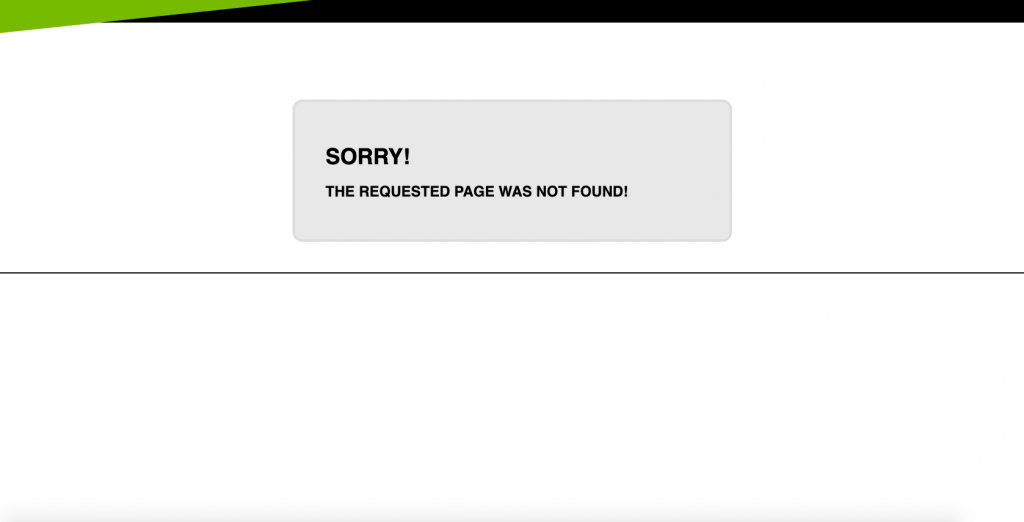

Here are some tips for creating a user- and SEO-friendly 404 error page for your website:
- Design the look and feel to match your website. Consider including your main navigation or a partial version of it.
- Apologize and tell the user what happened (try to keep it humorous to lighten the mood).
- Provide suggestions with links to other relevant product or category pages that the user would want to go to.
- Customize the 404 error page based on where the user was on the site (you’ll need access to a developer for this).
- Include a search box on your 404 error page. I recommend putting the search feature front and center.
- Provide a list of popular links to visit or product recommendations based off of products the user has looked at already.
Your users will appreciate a 404 error page that is actually helpful and friendly, rather than the standard browser-issued version. Below is a good example from Nixon of an optimized 404 page.
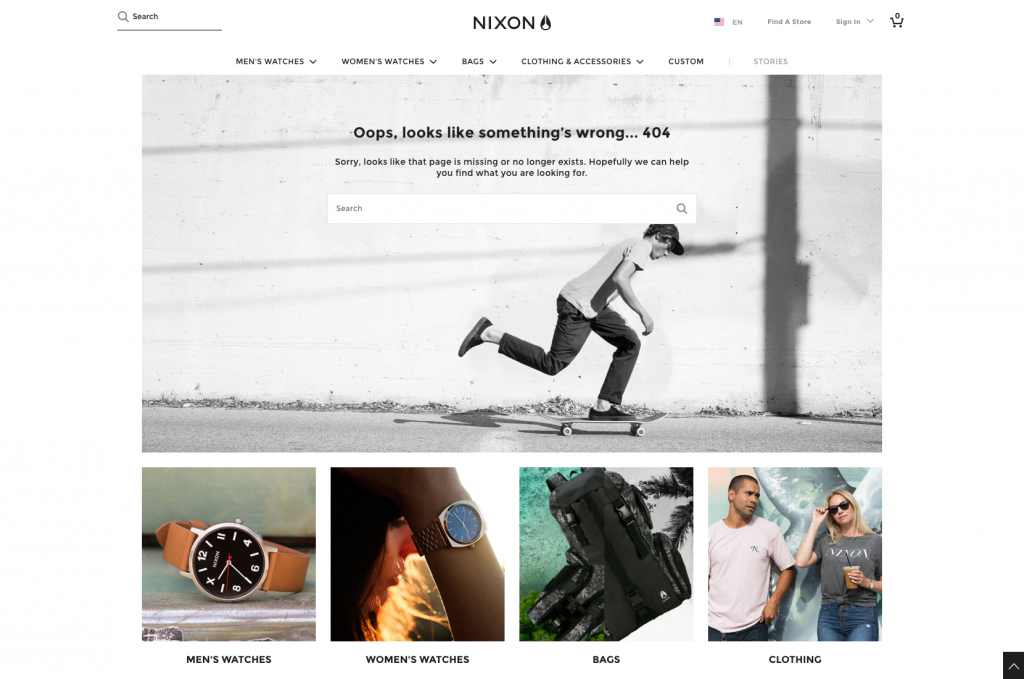

Now, let’s get back to what you came here for…
How to Handle Discontinued Product pages
Just because the product has been discontinued doesn’t mean that the demand for the product has also stopped. People may search for some products for years after they have been discontinued. For example, Cannondale’s Prophet mountain bike was made from 2005 to 2008, but the search interest continued at a fair rate until late 2013, as you can see in the graph below.
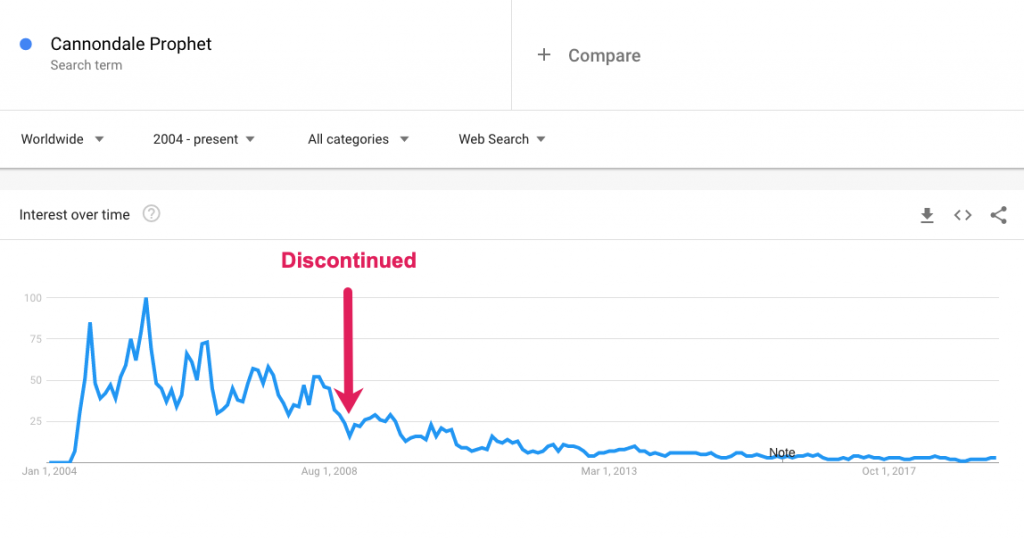

The continued search trend may be due to owners looking to purchase replacement parts, get product specifications, or to find owner’s manuals. Perhaps some people are looking to buy the bike after hearing good things about it (a fabulous opportunity to provide recommendations for similar bikes).
Offer Relevant Alternative Products to the Remaining Traffic
Determining whether or not to keep the discontinued product page accessible to users and indexable by search engines is another thing you need to consider. It’s only beneficial to keep the discontinued product page up if you have a relevant alternative product to offer users. Otherwise, it will serve no value to anyone.
So, if you do have a relevant product to offer in place of the discontinued one, something you need to look at is whether or not the discontinued product page is still getting relevant organic traffic and ranking well in search engines.
If you’re not getting relevant traffic, then you can jump to the next section below. If the product page is getting relevant organic traffic, then consider offering related products on the page for those remaining users that pass through. Start by letting the user know that the product they are looking for is no longer available, then provide some relevant alternatives.
Best Buy shows how it can be done:
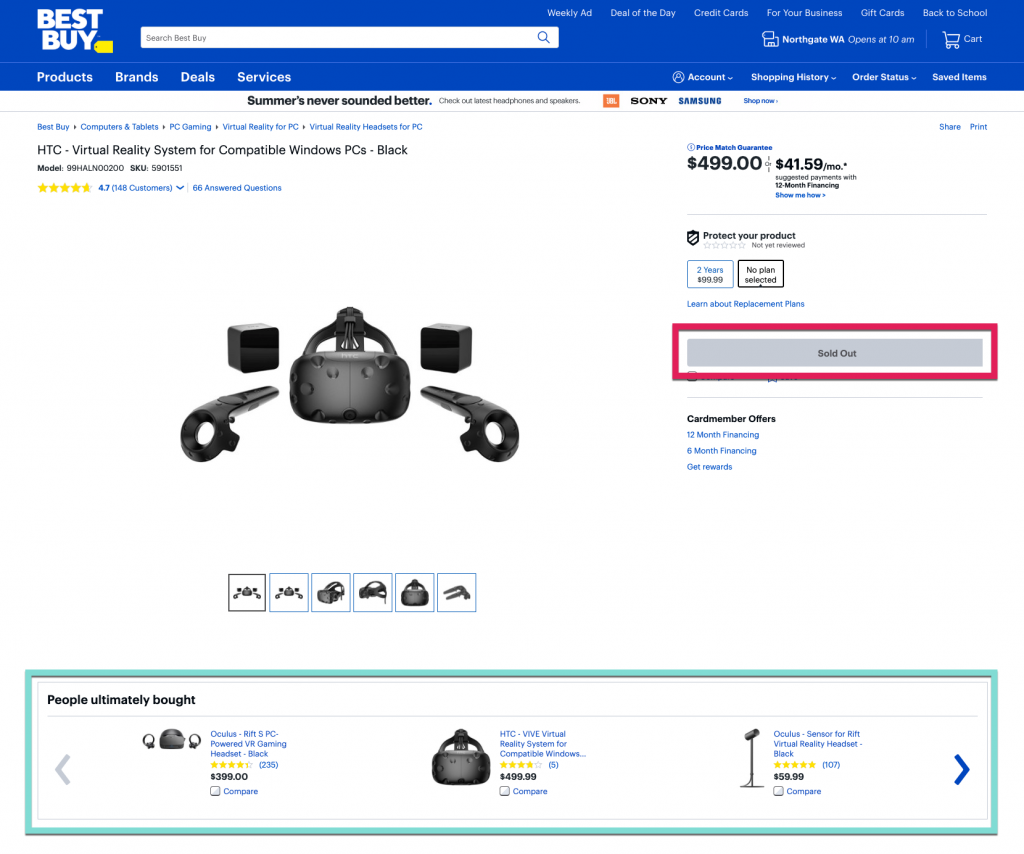

Keep in mind that the user is going to be disappointed that the item they are looking for is no longer available. So, your alternative suggestions need to be relevant to that product, or the user is unlikely to stick around and continue shopping.
Check the Page’s Organic and Referral Traffic Performance
Depending on the rate at which products go out of stock on your website, you could potentially damage your website’s SEO performance since Google doesn’t want to send users to sold-out product pages. So, check the organic and referral traffic performance of these discontinued product pages, and once organic traffic to the page has halted, you need to look into the page’s backlink quality and consider redirecting the page.
Does the Discontinued Product Page Have Backlinks?
Before you pull the trigger and delete the page because you have no alternative products to offer or no more traffic coming in, you should check to see if the product page has any backlinks. As you may know, backlinks are one of the most influential ranking factors used by search engines. You certainly don’t want to lose any of that value by deleting a page since 404 pages do not offer any link equity to your domain.
There are numerous tools that you can use to check for backlinks to your site. I recommend using tools like Moz’s Link Explorer, Ahrefs, or Majestic.
If you find that your discontinued product page does have quality backlinks, then 301 redirect (which is a permanent redirect) the page to a related product. If you don’t have a relevant similar product, then redirect the page to the relevant category or subcategory page. It’s crucial to avoid redirecting to a page that is also likely to become discontinued in the future. If you continue redirecting and redirecting again, you will have redirect chains on your website, which you want to avoid as it will negatively affect your page load times, user experience, crawl budget, and the link equity from the backlinks. If it is likely that the relevant product you want to redirect to could potentially be discontinued, then redirect to an appropriate category page as this is more likely to stay around for a while.
Keep in mind that being redirected without any explanation is very annoying, so choose when to redirect carefully. If possible, create a dynamically generated message that notifies your users that the product they are looking for is out of stock and they are being redirected to a relevant page.
How to Handle Temporarily Out of Stock Product Pages
When you have a product that is temporarily out of stock, you should keep the page live. You wouldn’t want to delete or redirect (not even a temporary redirect) these pages as the product will eventually be back in stock. However, you will want to provide some details to your users about the status of the product to indicate that the product is only temporarily unavailable.
If possible, give the user an idea of when the product will be back in stock or have them sign up for an email notification. Don’t forget to remove the option to add the item the cart. As recommended before, you can mitigate revenue losses by promoting relevant alternative products on the page while the product is temporarily sold out.
Ultimately, Keep Your Users in Mind
When managing out of stock product pages, you will need to use your best judgment and analysis to make the right decision for your website. When doing anything that will affect the user experience on your site, it is essential to keep your users in mind. By keeping your shoppers top of mind and doing what is best for your SEO, your website performance will improve, providing your users with a satisfying online experience.
The post How to Manage Out of Stock Products to Preserve Your SEO appeared first on Portent.
#1 Way To Generate Leads On Facebook & Instagram
1 Way To Generate Leads On Facebook & Instagram Are You A Realtor or LO? Start Booking More Appointments Here …
Read More →Instagram: The Perfect Social Networking Platform for Businesses
 It has already been discovered that Instagram has been responsible for surpassing both Facebook as well as Twitter in terms of the total number of users who are active. Currently, Instagram is the most preferred social networking platform that most of the businesses use for marketing their business. Instagram is simple, convenient, and user-friendly. The growing popularity of Instagram is what has helped businesses to trust this platform more in comparison to the various other platforms that are there. There are few businesses that are still confused as to why Instagram is ideal for them as well. According to blog.hootsuite.com, there are almost 25 million businesses on Instagram.
It has already been discovered that Instagram has been responsible for surpassing both Facebook as well as Twitter in terms of the total number of users who are active. Currently, Instagram is the most preferred social networking platform that most of the businesses use for marketing their business. Instagram is simple, convenient, and user-friendly. The growing popularity of Instagram is what has helped businesses to trust this platform more in comparison to the various other platforms that are there. There are few businesses that are still confused as to why Instagram is ideal for them as well. According to blog.hootsuite.com, there are almost 25 million businesses on Instagram.SEO Audit Checklist: Our Ever-Changing List
I’ve teased this for a while: Portent’s internal SEO audit checklist. Hope it’s helpful.
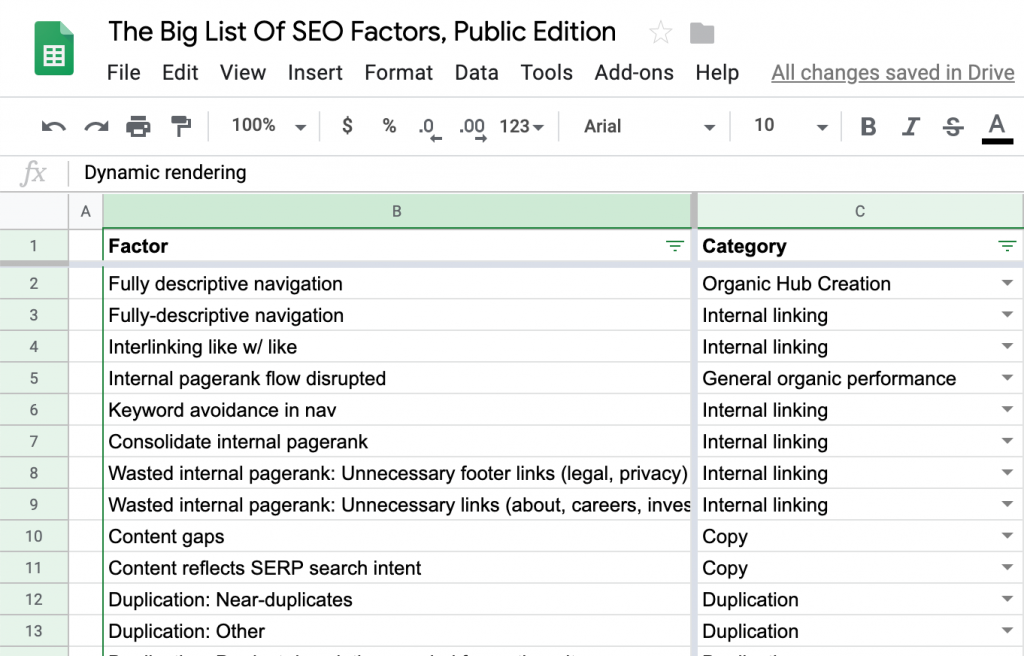

This list reflects our biases:
- Technical SEO is big
- Google Search Console is not
- Log file analysis pops up
- We consider link building a separate discipline that deserves its own checklist, so you won’t find it here
- We consider keyword analysis a separate discipline that includes content, SEO, social media and paid search, so you won’t find much about it here, either
This isn’t the whole list. Don’t judge me. We have to keep something for ourselves.
There’s some duplication. We’re only human.
We update the list regularly. When we update our internal checklist, we’ll update this one. Sometimes.
It’s definitely copyright Portent 2019. Steal this and make it your own, and we’ll find your pets, seduce them with treats, and take them home with us to pamper and spoil forever and ever. We’re petty. We’re not monsters.
Pssst: You can hire us to run an audit for you.
The post SEO Audit Checklist: Our Ever-Changing List appeared first on Portent.
The Basic Attribution Models Explained
Attribution, simply put, is a way to assign credit for sales or leads back to the initial marketing activities that drove it.
An attribution model is a way of assigning more or less credit to a marketing campaign, content, or channel depending on where in a customer’s journey they encountered it.
To demonstrate how attribution models work, let’s look at a hypothetical customer journey.
A Sample Customer Journey
Somebody discovers your brand through an ad on Google on a Monday. They browse around briefly, then leave.


On Wednesday, they scroll through their Facebook feed and see a retargeting ad and remembered the product they were looking at and visit again.


On Friday night, they’re hanging out at home on their couch with the tablet and recall your brand name from the previous day and search on Google, this time clicking on an organic listing. While at your site, they see a product they like, but it’s out of stock. They see an “email me when this product becomes available” call to action and sign up for the email reminder.


Next week, when the product comes back in stock they get the reminder email and visit your site again from that campaign. But they want to make sure they’re getting the best deal, so they go to a competitor’s website to check the price on a similar item.


Lastly, since they’re familiar with your brand now, instead of reopening the email they got earlier, they just go directly to the site, search for the item, and buy it for $100.


Applying Attribution Models
Now that we’ve laid out that customer journey, let’s look at how credit for that sale is assigned under a few attribution models.
Last Click Attribution
Last click attribution, sometimes called last touch, is the most common model and the most problematic for two reasons:
- By the time the last touch happens, a potential customer is already educated and familiar with your brand. Which means, they come directly to your site or search for your brand name in Google.
- Almost every analytics platform uses last touch attribution by default. annual shareholder reports tend to also use last touch attribution when talking about digital results. Why? Because they’ve been that way forever and old habits die hard.
Revisiting our customer journey using last click attribution, direct gets all the credit for the sale, completely obscuring the marketing efforts that came before it.


Incredible! Our brand strength is off the charts! Why are we even paying for traffic? Or to send out these expensive email blasts? Or to work with our SEO agency? We should stop doing all of that and just rely on word-of-mouth.
For more on the last click attribution problem, check out this post.
First Click Attribution
Under a first click (or first touch) attribution model the opposite is true; only the first stop in the user journey would get the entirety of the credit for that $100 sale. None of the other touch points leading up to that sale would be credited at all, even though they played an important role in the transaction.


So going back to our customer journey, if we paid $2 to generate that initial ad click, and the first touch attribution model tells us we generated $100 through that ad, we’d rightly think that our ROI for paid search is 50:1!
Wow! We should just shovel our entire marketing budget to Google Ads at that rate!
Linear Attribution
So why don’t we just give equal credit to all the touch points in a user journey and simplify everything? That’s what a linear model does.
We call it the “Participated Award” of attribution models. You did it, little Johnny! There are no winners and losers, but you tried really hard and that counts for something.


So everybody gets their $20 bucks, everybody’s happy, and we’re not necessarily any wiser about which channels are most effective for the business.
U-Shaped Attribution
Then there’s u-shaped, also called position-based attribution. Now we’re starting to get somewhere intelligent for retail.
We give the first touch lots of credit, for introducing someone to our brand. Last touch gets lots of credit for closing the deal. And then we sprinkle some loose change on the comparison shopping touches in between.


But is this really what we need? Maybe we sell a really big ticket item, more than $100 and less of a potential impulse buy. In this case, comparison shopping and research touches in the middle of the funnel become more vital.
Ramp Attribution
Then there’s a ramp model, which gives increasing credit to touches as they get closer to the sale. This is also called a time decay model in some attribution tools because it also factors in how long ago the first and middle touches occurred and downgrades the level of credit they get accordingly.


A ramp model is more effective for long sales cycles that require keeping people engaged with your brand over lengthy stretches of time, as well as B2B products and services that require long term commitments and contracts.
Getting Started with a Model
Just wrapping your head around what models are out there is a good first step, but the real gold is backing out to a customized attribution model based on your business and the most common customer journeys you encounter.
Google Analytics’ Model Comparison Tool allows you to apply any of the models we mentioned above on your historical data in a non-destructive way, so you can start to understand the value of considering your performance in a new light.
A word of warning though: once you get hooked on attribution, there’s no going back!
The post The Basic Attribution Models Explained appeared first on Portent.
Want To Be A Great PR And Marketing Professional? Be A Human Being
Running a great tech PR agency is grueling, but it isn’t art. It isn’t rocket science. Hell, I’d argue it’s not scientific at all, unless you call the gastrointestinal reaction that my body has to diet coke “science.” That’s why whenever I read PR people’s failed, slightly psychotic attempts to analyze how to talk to reporters, I throw my hands in the air. The article in question from Muckrack details, at length, how a PR study I’m not going to link to analyzed over 300 responses to emails from journalists, and is written with the cadence and curiosity of a neural network fed the names of a thousand brands.
Truly insanely obvious facts came from this study – that you got a positive response when you actually gave someone something they liked, and didn’t when you didn’t. “Unsurprisingly, the most positive type of feedback my team received were compliments on our work. This makes sense: publishers who immediately approve of our content are typically forward with their praise.” Thank you, PR study person, for telling me that people are happy when you do stuff they like.
I won’t go line by line, but the thing that made me roll my eyes the hardest was “…from this, we can observe that when pitching content, PR pros should have a deep sense of what the editorial process is like for each publisher.” Yes, learning what the reporter’s work is like is how you make them happy. Jesus CHRIST.
Something that has always confused me about public relations professionals is their complete lack of self awareness. There are dozens of similar posts to this one – such as Muckrack’s “two main reasons PR people annoy journalists” which instead of two blunt points includes two run-on sentences much like this one. God damnit.
You know what? Do you want to know how to be good at this job? Be a damn human being.
Want someone to like you? Read their damn work
I don’t care if you’re pitching a reporter, trying to be a growth hacker, trying to get new clients or trying to get a client to stop hating you. If you want to succeed in this job, you’re going to have to learn about the person in question and have a conversation that’s based on an informed understanding of their life. In the case of a reporter, a public relations professional should be able to say more than “I really liked this article!” They should have read a lot of the reporter’s work and said “hey, this reporter’s good, this pitch fits them, and it’s justified based on the things I’ve actually read.”
I realize a public relations and marketing person can be seen as the lowest form of life, below the humble cockroach and the snail. But imagine yourself in their shoes – wouldn’t you want someone who’s asking you to do something for them to know about you? To understand and appreciate you? It’s so obvious!
Public relations and marketing success stories come from actual human connections
Watching PR people try and talk to reporters on Twitter is painful. You watch them desperately try and make jokes, or try and say “wow, great article!” Most “how to make a relationship” PR posts say to read their work, to talk to them where they like to be talked to, and to share their work on Twitter. The reason this often doesn’t work is because you need to actually try and get to know them. This doesn’t need to be encyclopedic, nor does this mean you even have to meet them. It means you have to read their articles, their feed, and if you do meet them you have to talk to them not about your clients. You have to be able to discuss something other than your clients, and something other than your immediate workspace.
You have to be a semi-interesting and well-rounded person with an actual personality
If you’re a person that can only talk about your industry and your work, you’re likely dull as hell! A lot of PR people feel like they’re printed from the same boring fax machine, sent to this world to have the same asinine platitudes about doggos and puppers, or how they love running or something. Most reporters consider PR people a homogenous lump because they actually are. If your only experience – professionally and personally – leads you to be only able to talk about your clients, their industry, and whatever has happened to you at work, you’re likely a very big boring person that nobody wants to talk to. This means that you may have to open a book that’s not related to work, or learn an instrument, or broaden your horizons beyond what everyone you know likes.
I’m going to, at some point, write a series about how to make the average PR and marketing person more interesting. Maybe I’ll start tomorrow.
The post Want To Be A Great PR And Marketing Professional? Be A Human Being appeared first on The Future Buzz.
The Contactcentre as a Profitcentre
I don’t think there is any need to push the statement “a great customer experience leads to happier customers, which in turn leads to higher profit” anymore – over the past 20 years we have seen thousands of books and articles, and a multitude of that number in PowerPoint slides, proving time and again that happier customers lead to faster growth, increased share prices against the not-so-customer-centric peer group, more loyalty/less churn, etc.
How to Maximize ROI on Your Ads
- Website Optimization
- Search Engine Optimization
- Social Media Attack!
- Customer Service
Are You Using the Right Attribution Model in Google Ads?
Do you know the value of your Google Ads investment?
As marketers, we have what can feel like endless options to utilize our often limited marketing budgets.
How do you know where to invest? PPC is often a low-funnel highly-targeted place to start, but how do you justify the results you are driving? Should you be spending more? Less?
All these questions are crucial to getting the most out of your broader marketing mix. But the answer isn’t always as straightforward as it seems, even in the world of PPC where calculating your ROI is often much easier than most other digital channels (and certainly easier than more traditional marketing channels).
It sounds simple. You have Google Analytics and conversion tracking set up. So you ask yourself, “did my click result in a conversion?”
But many other questions come from this. How much is a conversion worth? How often do your conversions result in revenue? What are your margins?
These are much larger questions that we’ll save for another blog post. The one we’ll focus on here is simply, “who deserves credit for a conversion?” And that brings us to attribution.
What is Attribution?
Attribution is considered by many to be the most important marketing argument. In marketing, attribution is the action of deducing what deserves credit for a conversion. Sounds relatively straightforward, right?
However, things can get messy quickly as sales funnels get longer. For instance, what deserves credit for the conversion in this user path scenario?


Google Ads and Google Analytics both default to an attribution model called last click. So with those defaults in place, as many businesses use, 100% of the credit for the conversion above would go to a direct site visit, despite the heavy influence paid search, paid social, and display played in the nine-step path this user traveled down on their way to converting.
When you lay it out like that, it’s easy to see there are unlimited different combinations of touchpoints that could result in a conversion…so maybe last click doesn’t always fit.
Let’s take a look at the other attribution models available within Google Ads.
Attribution Models
In Google Ads, there are six different attribution models to choose from that distribute credit in different ways. I’ll go through them and discuss when you might want to use each.
Last Click
Last click attribution gives 100% of the credit for a conversion to an ad when it was the last click that led to the conversion (again, this is the default setting).


Example: This model is best used when trying to identify which channels are most responsible for bottom of the funnel deal closing.
First Click
First click gives 100% of the credit for a conversion to an ad that was the first click in a path that led to a conversion.


Example: This model is best used when trying to identify how users are introduced to your brand (new users).
Linear
Credit is distributed evenly across all clicks that the user had on their way to a conversion.


Example: This model is more useful when you are trying to understand how all your channels are playing a role in a conversion.
Time Decay
Credit is weighed by the click’s proximity to the conversion using a seven-day half-life. A click eight days before a conversion gets half the credit of a click one day before the conversion.


Example: This model is best used when trying to learn what strategies are better brand introducers and what strategies drive the most conversions.
Position-Based
Credit is distributed with 40% credit towards the first click and 40% credit towards the last clicks. The remaining 20% is spread evenly between the clicks in the middle.


Example: This model is most useful when you value brand introduction and conversion driving the most.
Data Driven
Credit is shared based on the weight of each click. Clicks that play a more significant role historically in driving conversion earn more weight. This model is specific to each advertiser’s individual conversion data.


Example: This model is the most scientific. It uses algorithms to weigh conversions, and with enough data, is most useful when trying to understand which channels are playing the largest role in driving conversions.
Each model has pros and cons inherently. So how do you pick one that is going to work for you?
Choosing an Attribution Model
In many cases, we are all so used to last click attribution that it’s hard to buck the trend and start fresh with something new, even if we know it is misrepresenting the data. We all have reports to create and people to report to.
With that in mind, it’s important to decide on a model using facts, data, and a clear understanding of your goals and expectations.
Google Analytics has a nifty tool to help.
Model Comparison Tool
In Google Analytics under Conversions > Attribution you will find the Model Comparison Tool.
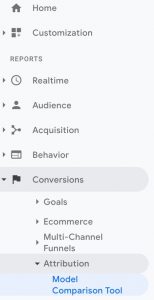

This tool allows you to pit up to three different attribution models against one another for the same data set to see how your conversion data changes as you begin to consider different models.
Specifically, you can toggle the tool to just view Google Ads data.


Start with Last Interaction (i.e. last click) and start comparing different models. Check the “% change in conversion” column to begin to get a picture of how Google Ads performs differently with a different model in place. You’ll start to notice that some campaigns and strategies are affected differently by different models.
Before Making a Switch
There is a lot to consider before making the jump to a new model in Google Ads.
Consider your business goals. What are you trying to get out of Google Ads? If you are investing significant budget into Google Ads, it’s likely you are expecting conversions. But are you limiting yourself in scenarios like the one we outlined at the start?
Review your Top Conversion Paths in Google Analytics to learn what paths users are most often taking.
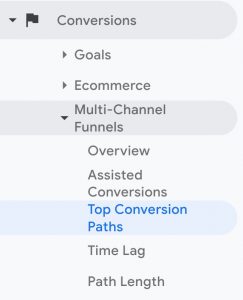

When you do change your attribution model in the Conversions section of Google Ads, your data will begin to shift and it will not retroactively update historical data. You’ve most likely been optimizing towards one model for some time, so make sure everyone is on the same page before switching.
Final Thoughts
Attribution is a huge question, and most of the biggest brands and highest spending advertisers struggle with it. There is very likely not a one size fits all answer to “the right” attribution model for you.
But just because the industry default has historically been last click doesn’t mean you have to continue the trend. Weigh your options, look at the data, consider your goals, and pick a model that reflects your strategies and business.
Once you settle on a new, more accurate model, you can begin collecting new data. In theory, the new data will be more representative of your goals, so you should be able to start making optimizations off it that will help improve your overall business KPIs.
The post Are You Using the Right Attribution Model in Google Ads? appeared first on Portent.
How Do You Promote Your Web Design Venture with Instagram?
 Today, the competition is stiff and businesses are facing more resistance than ever from other competitors in the market. Therefore, you must promote your design services beyond the typical markets. Read on to learn how you can promote your web design business with Instagram.
Today, the competition is stiff and businesses are facing more resistance than ever from other competitors in the market. Therefore, you must promote your design services beyond the typical markets. Read on to learn how you can promote your web design business with Instagram.
Boost Brand Awareness
You will need to highlight your design business through Instagram marketing. This way, you will gain likes, comments, and shares to grow your business, increase online visibility and brand awareness. You can opt for increasing your likes through organic or paid marketing depending on your business requirement and budget. You will find numerous social media tools to take your branding efforts to the next level using Instagram.
Also Read
Tips to Improve Your Business Online Presence with Social Media
Improve Customer Engagement
The basic reason why small business owners do not have websites because they think the process as complicated. As a designer, you can simply use your web page layout with Instagram photos and videos. There is no doubt about the same.
You can create short videos to explain some of your design philosophy and post the same on the photo-sharing platform. Again, leverage Instagram stories to show you work on your design projects or share a client video appreciating your work. This way, you can gain more followers for Instagram than ever.
Make the Most out of Instagram Visuals
When it comes to Instagram, it is about high-definition photos and videos. Therefore, pique audience interest by displaying your web design samples in a creative manner. This way, your web designing skills will be noticed and potential clients would start showing interest in your work. Post new design samples and schedule the posts.
Again, use your landing page design to offer a discount on your web design, responsive design, and graphics, and logo design services to grab client attention.
Drive Quality Traffic to Your Business Website
You need to ensure that prospective customers visit your website and understand what your web design services have to offer. You need leads and conversions. There are many ways to drive traffic but Instagram marketing is your best bet. You are targeting a huge audience base. Therefore, include a link in your Instagram bio and post unique, eye-catching, relevant, and innovative photos and videos to ensure increased traffic to your website.
If you are new to Instagram, take some time out of your busy schedule and read online blogs and tutorials to use Instagram for your web design business. Put some effort and you will succeed if you are serious about growing your business. Try this tactic and you’ll be surprised by the results.
Conclusion
Now that you have these tips handy, consider them to grow your web design business and boost brand awareness.
Author Bio
Walter Moore is a renowned management expert and digital marketing expert. He is an experienced digital marketer and has helped e-commerce businesses in all niches gain with his effective marketing strategies and guidance.





